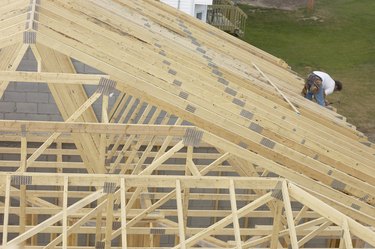
According to Joe Hurst-Wajszczuk with This Old House, truss uplift is the cause of roughly 20 percent of cases in which ceilings and walls separate. Other causes include support beams that are too small, clay soil that expands with moisture and floor joists or other framing lumber that have not been properly dried before being used. All of these problems are difficult to remedy without tearing down the home, relocating it or starting from scratch, except in the case of truss uplift.
Trusses
Video of the Day
Newer homes built using roof trusses experience uplift and develop gaps between the walls and ceilings. Roof trusses are the wooden framework that supports the area between the ceiling and the roof. They are located in the attic. Trusses have largely taken the place of the old rafter and joist framing, as they are bought pre-fabricated and are less expensive and faster to install than stick-built frames.
Video of the Day
Differentials
The truss consists of upper and lower chords. The upper chord supports the roof. The upper story ceiling is attached to the lower chord. To keep heat from escaping through the ceiling of the house, heavy insulation is laid over the lower chord, while the upper is exposed to the colder, damper air of an uninsulated attic. This differential causes varying rates of expansion as outdoor temperatures and conditions fluctuate.
Result
As the upper chord of the truss soaks up moisture and expands, then cools off and contracts, the protected lower chord remains consistently warm and maintains a relatively steady moisture content. The result is a truss that swells, lifting the entire structure and pulling the ceiling with it. Gaps are usually most common on the upper story and toward the center of the structure.
Walls
Inside the home, drywall that has been securely fastened to the ceiling, which in turn is securely fastened to the truss, can't float or stretch to keep up with the movement of the ceiling. Consequently, an ugly crack opens between the wall and the ceiling. Homeowners will notice that, if truss uplift is the cause of the crack, the crack will disappear as warmer temperatures return.
Damage
While the appearance of a gap between walls and ceilings is unsightly and often causes alarm, it is a harmless effect that is largely unavoidable. If building a new home, requesting the use of truss clips can eliminate future truss uplift. In existing homes, it is best solved with the installation of crown molding. Attach the molding to the ceiling, and allow it to float freely over the wall, effectively concealing any cracks or gaps that occur.